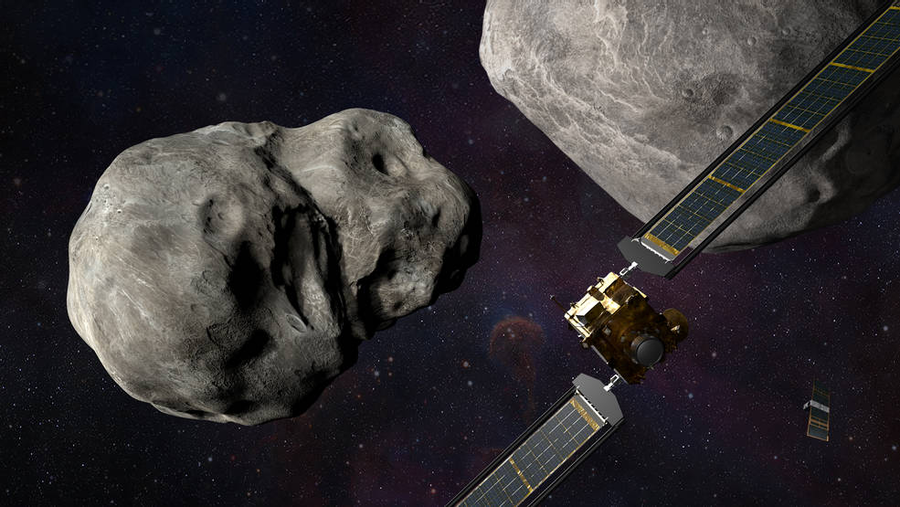Countdown to DART Impact
If all goes according to plan, on September 26th at 7:14 pm Eastern Daylight Time, NASA’s DART spacecraft will meet a fiery end. DART, whose name stands for Double Asteroid Redirection Test, is poised to intentionally crash into an asteroid that, at the time of impact, will be 11 million km from Earth. The goal of the mission is to alter the speed and trajectory of the impacted space boulder. The technology developed for the mission could one day aid in shifting the orbit of an asteroid that—unlike this one—is on a collision course with Earth.
“Our DART spacecraft is going to impact an asteroid in humanity’s first attempt to change the motion of a natural celestial body,” said Tom Statler, a scientist in NASA’s planetary defense team, in a recent press conference about the mission. “It will be a truly historic moment for the entire world.”
Launched at the end of November 2021, the DART spacecraft has spent the last 10 months zipping through space toward a pair of asteroids named Didymous and Dimorphous. Dimorphous—the smaller of the pair—has a diameter of 160 m, about the length of one-and-a-half soccer fields. Didymous is about 5 times larger. Little else is known of the shape, mass, or composition of these giant space boulders.
Dimorphous orbits Didymous on a path that occasionally brings the two in-line with each other, as seen from Earth’s perspective. From the timing of these eclipse-like alignments, astronomers have determined the orbital period to be 11 hours and 55 minutes. The DART team expects the impact to shorten this period by a few minutes, as the force from the collision pushes the moonlet asteroid toward its planetoid, decreasing the separation by about 1%. (At the time of impact, DART will have a mass of 570 kg and be moving at 6.1 km/s relative to Dimorphous.) “It’s only going to cause a small change in how Dimorphous goes around Didymous,” said Nancy Chalbot, one of the DART team leaders. “That makes it a very safe and efficient way to do this first test.”
For the DART team, which includes scientists from space agencies and research institutions around the world, the test has two parts: hitting Dimorphous and then deflecting its path. To hit its target, DART will need to autonomously identify the moonlet asteroid and then self-adjust its trajectory to keep on target. “[DART] won’t be able to distinguish between Didymous and Dimorphous until the last hour of the mission,” Chalbot said. At that time, the spacecraft will be too far from Earth for any course-adjusting signals to reach it before the countdown ends. Instead, DART will have to continuously snap images of the asteroids and then use algorithms onboard its computer to interpret those images and make the course adjustments needed to ensure an intercept.
The images that DART captures will also stream back to Earth. They will be broadcast live on NASA TV starting at the T-minus-1-hour-and-14-minute mark when Didymous and Dimorphous should both be visible as tiny bright dots. The dots will then grow larger, gradually transforming into gray blobs before becoming recognizable as asteroids. The view will then shift to Dimorphous, offering onlookers an up close view of this never-before-imaged asteroid. It will be “absolutely amazing,” said Patrick Michel the lead scientist on the European Space Agency’s space safety program. “Little by little the images will come, and the scientists and the public will share together the excitement of discovering a new territory.”
While the world will know at 7:14 pm EDT whether the first part of the mission succeeded—if the camera keeps rolling, then DART missed its target—it will be another few days before data on the effects of the impact starts arriving. LICIACube—the Light Italian CubeSat for Imaging of Asteroids that accompanies DART—is scheduled to pass Dimorphous at the time of the impact and will capture what happens when DART hits. Meanwhile, telescopes on every continent will track the orbit of Dimorphous to assess the second part of the mission—whether the impact changed the asteroid’s path.
Those orbit observations will take time. Statler explained the situation with a wristwatch analogy. If your wristwatch begins to run a second too fast—or too slow—you may not notice until a few weeks later that its timekeeping is off. Scientists expect the same delay in accurately measuring Didymous’ speedup. “I personally wouldn’t be surprised if a month went by and we still did not have a clear detection of that change,” Statler said. He noted that with so many unknowns about the asteroid, it’s “difficult” to give a more precise time frame.
In the meantime, Statler, Chalbot, and others emphasize that this mission is just a test—Didymous is not a killer asteroid heading for Earth. “In fact, there are no known asteroid threats to the Earth for the foreseeable future,” Chalbot said. Scientists have tracked the trajectories of 98% of the largest near-Earth objects and none are in imminent danger of hitting Earth. That said, astronomers continue to find new objects with diameters similar to that of Didymous, and one of those asteroids might eventually pose a threat. “If one were to hit Earth, it could be regionally devasting with carry[over] effects that would affect everybody on the planet,” Statler said.
–Katherine Wright
Katherine Wright is the Deputy Editor of Physics Magazine.





